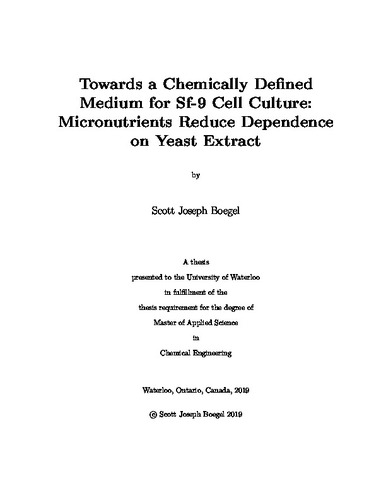| dc.description.abstract | Spodoptera frugiperda clonal isolate 9 (Sf-9) insect cells in conjunction with recombinant baculovirus are an industrially relevant system for producing biologics. Sf-9 cells are capable of robust high-density growth in single cell suspension. However, unlike many other continuous cell lines, Sf-9 cell culture media remains undefined. Typically, the growth medium requires undefined hydrolysate supplementation (most often yeast extract) in order to support cell proliferation. The lack of chemical definition makes medium and process optimization difficult, leads to batch-to-batch variability, and potentially affects downstream processing. This work aims to combine available information on the composition of yeast extract and the composition of media for other cell lines to reduce the concentration of undefined components (yeast extract) in the medium and elucidate the effects of micronutrient compounds.
Utilizing an in-house medium based on the classic IPL-41 medium with yeast extract as the only undefined component, several steps were taken towards chemical definition. Through fortifying the trace metal and vitamin content in the medium and the addition of 11 micronutrients, the yeast extract content was successfully reduced 10-fold (from 4 g/L to 0.4 g/L). Without medium fortification and micronutrient addition, the cells were incapable of growth at low yeast extract concentration. Sf-9 cells adapted to this new medium were capable of long-term consistent growth. Micronutrients of key importance in this medium were identified as glycine betaine, ascorbic acid, and the polyamine putrescine. The presence of glycine betaine (1 mM), ascorbic acid (10 uM), and putrescine (10 uM) improved maximum cell density by 32%, 41%, and 28% respectively in the low yeast extract medium. The role of these micronutrients could be properly investigated only after medium enhancement and yeast extract reduction. Further, this medium was found to be cost-effective compared to commercially available alternatives and the potential for added cost-savings related to lipid supplementation was identified.
This enhanced low yeast extract medium could allow for micronutrient and other component investigation with less convolution and is particularly applicable to designed compound screening experiments (e.g. Plackett-Burman). Identification and supplementation of additional required components provided solely by the yeast extract could lead to a chemically defined medium. | en |

